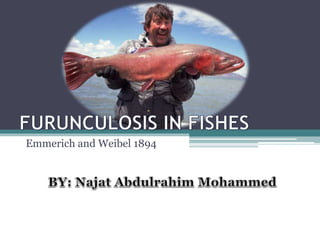
Aeromonas salmonicida
- 1. Emmerich and Weibel 1894
- 2. CONTENTS: What is Furunculosis? What is the causal agent? What are the signs of infection? How to diagnose that disease? Epizootiology: ▫ Geographic and host ranges. ▫ Sources and reservoirs of infection. ▫ Modes of transmission. ▫ Incubation period. What are the methods of control?
- 3. What is Furunculosis? • Furunculosis is a serious, septicemic*, bacterial disease. • Found principally in salmonid fishes. • The common name of the disease is derived from the presence of “blisters” or furuncules on the surface of chronically infected* salmonids.
- 4. What is the causal agent? • Bacterial species: Aeromonas salmonicida*. •After about a 24 hour growth period the colonies are about the size of a pin point. •The colonies also have a brown pigmented color that appears after it has been growing for 48-72 hours.
- 5. After Staining and Microscopic Examination: A gram-negative bacillus Non-motile Optimum growth temp: 22 and 25°C Maximum growth temperature at 34.5°C
- 6. Biochemical Tests: • It is negative for • Indole Formation Test • Voges-proskauer Test • Citrate Utilization Test • Coagulase Test • Starch Hydrolysis • Casein Hydrolysis • Triglyceride Hydrolysis • Phospholipid Hydrolysis • Hydrogen Sulfide Production • Citrate Utilization • The Phenylalanine Test. It is positive for: Oxidase test Lysine decarboxlase test Methyl red test Gelatin hydrolysis test Catalase test.
- 7. What are the signs of infection? • Fingerlings: exhibit hemorrhages at the base of fins and erosion of the pectoral fins. (rare) • In chronically infected adults, typical “furuncules” or blisters on the skin containing an amorphous yellow substance and blood may be present.
- 8. What are the signs of infection? • Internal examinations frequently reveal a bloody fluid in the body cavity. • Petechial hemorrhages are commonly observed in the body wall and viscera.
- 9. How to diagnose that disease? • Bacteriological culture. • Biochemical testing. • Histopathology. • Molecular confirmation.
- 10. EPIZOOTIOLOGY:
- 11. Geographic And Host Ranges • Epizootics have been diagnosed in numerous cool and warmwater species • Disease is distributed worldwide except of Australia and south America wherever trout and salmon and golden fish are reared.
- 12. SOURCES AND RESERVOIRS OF INFECTION • Aeromonas salmonicida is considered to be an obligate pathogen of fish. • It has not been found when diseased or carrier fish are absent. • The organism may survive for days or weeks in water but cannot persist indefinitely in the absence of carrier fish.
- 13. MODES OF TRANSMISSION • Contact with infected or carrier fish. • Through contaminated water. • Contaminated clothing from one culture to another. • Through eggs if they are contaminated. • It doesn’t invade the pathogen unless there are an injury on the skin surface. ( or experimentally)
- 14. Incubation period: • About 2-4 days. • In very cold weather extend to several weeks. • High disease infection in midsummer (July- August )* (12C- 21C) *New York City Weather
- 15. METHODS OF CONTROL • Tanks disinfection. • Eggs disinfection. • Water supply kept free of fish. • Periodically inspection
- 16. THERAPY • Terramycin (oxytetracycliie) should be added. • Sulfamerazine • Care should be taken.
- 17. Source: • http://www.glfc.org/pubs/SpecialPubs/sp83_2/pdf/chap25.pdf • http://en.wikipedia.org/wiki/Aeromonas_salmonicida • http://www.scotland.gov.uk/Topics/marine/Fish- Shellfish/aquaculture/diseases/notifiableDisease/Furunculosis/Aeromonas • Hint: Pictures in this presentation are taken from internet websites.
- 18. • Thanks For listening!
Editor's Notes
- Septicemic: Systemic infection of the blood by pathogenic microorganisms, especially bacteria, that originate from a localized source. Also called blood poisoning. systemic infection : infection in which the pathogen is distributed throughout the body rather than concentrated in one area. Infection: . invasion and multiplication of microorganisms in body tissues, especially that causing local cellular injury due to competitive metabolism, toxins, intracellular replication or antigen-antibody response.
- described by Griftin et al. (1953)*
- Genome structureCell structure and metabolismAeromonas salmonicida is bacillus in shape. The short rods have rounded ends which allow it to be easily confused as a coccus. The colony size of Aeromonas salmonicida is between 1-2nm. Aeromonas salmonicida is a facultative anaerobic which means that it is capable of making ATP by aerobic respiration if oxygen is present but is also capable of switching to fermentation when oxygen is not present. It does not have fermentation of sucrose or lactose but it does of glucose. The glucose fermentation also created gas.Quorum sensingIn response to an increase in bacterial population, Aeromonas salmonicida uses quorum sensing to control gene expression. Quorum sensing is controlled through the release of a molecule called AHL, which is an N-linked acyl chain of either four or six carbons. As a result of quorum sensing, A. salmonicida produces and releases serine protease. The release of serine protease also makes this bacterial species virulent. There are twenty-five strains of A. salmonicida; three of the strains contain R factors that make the bacteria drug resistant. NCMB833, one of the three strains, is resistant to tetracycline and sulfathiazole, while Ar-32 and Ar-33 are resistant to sulfathiazole, chloramphenicol, and streptomycin.
- All lots of fish in a hatchery should be inspected at least once per year for the presence of disease. All eggs from susceptible species should be routinely disinfected using organic iodine compounds The hatchery water supply should be kept free of fish. Barriers should be provided to prevent the introduction of potential wild carrier fish into the hatchery.